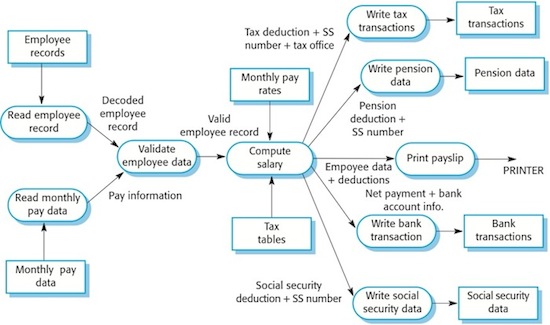
Businesses rely on data processing systems to support many aspects of their business such as paying salaries, calculating and printing invoices, maintaining accounts and issuing renewals for insurance policies. As the name implies, these systems focus on data and the databases that they rely on are usually orders of magnitude larger than the systems themselves. Data processing systems are batch processing systems where data is input and output in batches from a file or database rather than input from and output to a user terminal. These systems select data from the input records and, depending on the value of fields in the records, take some actions specified in the program. They may then write back the result of the computation to the database and format the input and computed output for printing.

Figure 1 An input-process-output model of a data processing system
The architecture of batch processing systems has three major components, as illustrated in Figure 1. An input component collects inputs from one or more sources; a processing component makes computations using these inputs; and an output component generates outputs to be written back to the database and printed. For example, a telephone billing system takes customer records and telephone meter readings (inputs) from an exchange switch, computes the costs for each customer (process) and then prints bills (outputs) for each customer.
The input, processing and output components may themselves be further decomposed into an input-process-output structure. For example:
The nature of data processing systems where records or transactions are processed serially with no need to maintain state across transactions means that these systems are naturally function-oriented rather than object-oriented. Functions are components that do not maintain internal state information from one invocation to another. Data-flow diagrams, are a good way to describe the architecture of business data processing systems.
Data-flow diagrams are a way of representing function-oriented systems where each round-edged rectangle in the data flow represents a function that implements some data transformation, and each arrow represents a data item that is processed by the function. Files or data stores are represented as rectangles. The advantage of data-flow diagrams is that they show end-to-end processing. That is, you can see all of the functions that act on data as it moves through the stages of the system. The fundamental data-flow structure consists of an input function that passes data to a processing function and then to an output function.

Figure 2 Data-flow diagram of a payroll system
Figure 2 illustrates how data-flow diagrams can be used to show a more detailed view of the architecture of a data processing system. This figure shows the design of a salary payment system. In this system, information about employees in the organisation is read into the system, monthly salary and deductions are computed, and payments are made. You can see how this system follows the basic input-process-output structure:
The architectural model of data processing programs is relatively simple. However, in those systems the complexity of the application is often reflected in the data being processed. Designing the system architecture therefore involves thinking about the data architecture (Bracket, 1994) as well as the program architecture. The design of data architectures is outside the scope of this book.
Bracket (1994).